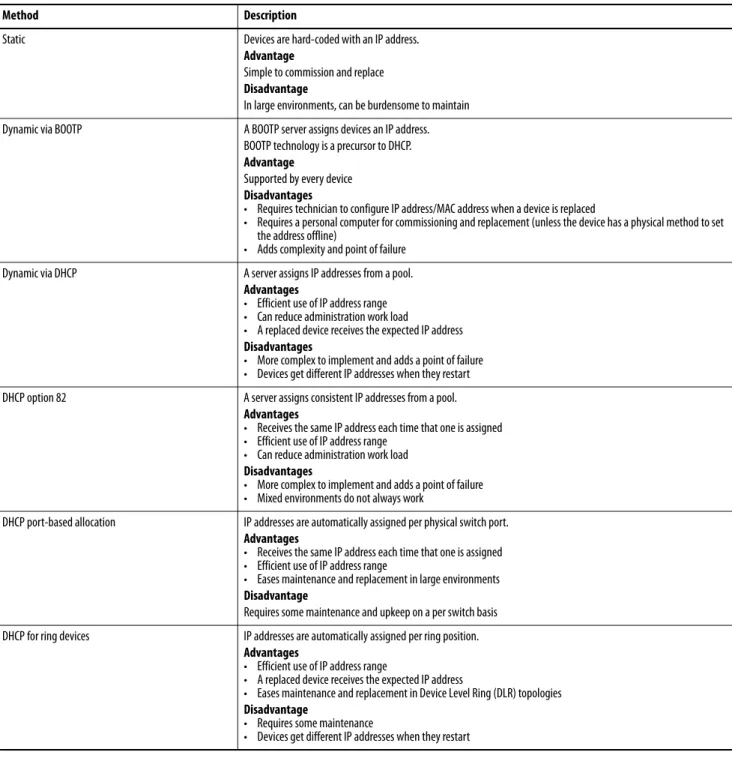EtherNet/IP Network Specifications moved to Ethernet/IP Network Devices User Guide, Publication ENET-UM006. Provides an overview of the technologies used in EtherNet/IP™ networks and provides guidance for deploying infrastructure devices in EtherNet/IP networks. EtherNet/IP Network Devices User Guide, ENET-UM006 Describes how to configure and use EtherNet/IP devices with a Logix 5000™ controller and how to communicate with various devices on the Ethernet network.
EtherNet/IP Parallel Redundancy Protocol Application Techniques, ENET-AT006 Describes Parallel Redundancy Protocol (PRP) topologies, configuration considerations, and diagnostic methods. EtherNet/IP Device Level Ring Usage Techniques, Publication ENET-AT007 Describes device level ring (DLR) topologies, configuration considerations, and diagnostic methods. QuickConnect technology allows EtherNet/IP devices to quickly turn on and join an EtherNet/IP network.
EtherNet/IP Socket Interface Application Technique, publication ENET-AT002 Describes the socket interface used to program MSG instructions to. Industrial Automation Wiring and Grounding Guidelines, publication 1770-4.1 Provides general guidelines for installing a Rockwell Automation industrial system.

The IP address identifies each node on the IP network or system of connected networks. The IP address is 32 bits long and has a network ID part and a host ID part. In an Ethernet environment, B can then resolve the IP address of host C to a MAC address and communicate with C directly.
When host B communicates with host A, it knows from the IP address of host A that A is on a different network because the network IDs are different. To send data to A, B must have the IP address of the gateway connecting the two networks. The ARP cache entries in other devices are now invalid because the MAC ID corresponding to the IP address of the module has changed.
When a client device receives an IP address for a name, it stores it in its own table. The device still sends an ARP request if it needs to decode an IP address into a hardware address.

For more information about DLR, refer to Device Level Ring Implementation Technique, publication ENET-AT007. Key-Based Ring A ring network is a fault-tolerant ring network that is intended for interconnecting devices. The shutdown of a device or the failure of a device at the center of the network affects the connection between any of the devices on either side.
Device Level Ring (DLR) – built-in switch The DLR network is a single-fault tolerant ring network intended for interconnection of automation devices. The EtherNet/IP embedded switch technology enables this topology to be implemented at the device level. Media The actual wire used for the network is called the physical medium.
The network is not directly connected to the IT network - All nodes in the network are Rockwell Automation devices - There is no possibility of overloading the device with traffic. IMPORTANT The speed and duplex settings for devices on the same Ethernet network must be the same to prevent transmission errors.

When a packet is received on a port, the switch compares the fields in the packet with any ACLs applied to the port. Based on the criteria in the ACL, the switch determines whether the packet has the required conditions to be forwarded. Dynamic Host Configuration Protocol (DHCP) assigns IP address information from a pool of available addresses to newly connected devices (DHCP clients) in the network.
Each IP address you add to a group must be unique and not currently in use by another device on the network. If one of the ports in the channel becomes unreachable, traffic is transferred through the remaining ports in the channel. A disabled port in a port channel is treated as a link failure and its traffic is forwarded to one of the remaining ports in the channel.
If one of the ports in the port channel becomes unavailable, traffic is sent through the remaining ports within the port channel. In this mode, the port drops any traffic from an address that is not on the list of allowed MAC addresses. When there is a network failure, the blocked port returns to the forwarding state to minimize network disruption.
If all ports in the segment are operational, one port (called the ALT port) is in the blocked state for each VLAN. If VLAN load balancing is configured, the two ALT ports in the segment monitor the blocked VLAN state. A port is declared up after it performs a three-way handshake with a neighbor on the same segment.
By entering the neighbor offset number of a port in the segment, which identifies the downstream neighbor port of an edge port. When VLAN load balancing is triggered, the primary edge port broadcasts a message to alert all interfaces in the segment about the preemption. To change an STP ring configuration to a REP segment configuration, configure one port in the ring as part of the segment.
Rack-optimized A rack-optimized connection is an implicit message connection to a rack or mounting object on the EtherNet/IP communication module. Implicit refers to information (such as source address, data type, or destination address) that is implied in the message but not. Implicit refers to information (source address, data type, and destination address) that is implied in the message but not contained in the message.
Explicit messages use an explicit message protocol in the data portion of the message packet.






